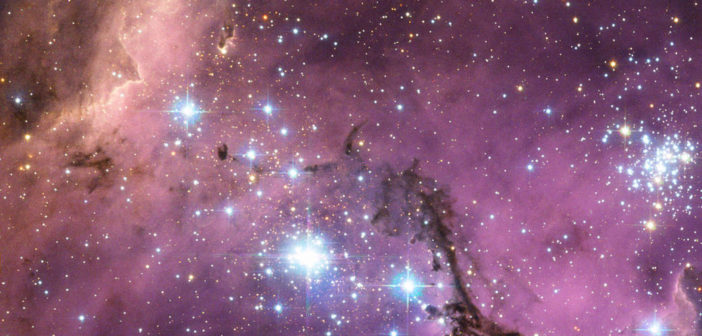For the first time, data from the Atacama Large Millimeter/submillimeter Array (ALMA) reveal the presence of methyl formate and dimethyl ether in a star-forming region outside our galaxy. This discovery has important implications for the formation and survival of complex organic compounds — important for the formation of life — in low-metallicity galaxies both young and old.
No Simple Picture of Complex Molecule Formation

ALMA, pictured here with the Magellanic Clouds above, has observed organic molecules in our Milky Way Galaxy —
and beyond. [ESO/C. Malin]
In our galaxy, complex organic molecules are often found in the intense environments of hot cores — clumps of dense molecular gas surrounding the sites of star formation. However, it’s not yet fully understood how the complex organic molecules found in hot cores come to be. One possibility is that the compounds condense onto cold dust grains long before the young stars begin heating their natal shrouds. Alternatively, they might assemble themselves from the hot, dense gas surrounding the blazing protostars.

Composite infrared and optical image of the N 113 star-forming region in the LMC. The ALMA coverage is indicated by the gray line. Click to enlarge. [Sewiło et al. 2018]
Detecting Complexity, a Galaxy Away
Using ALMA, a team of researchers led by Marta Sewiło (NASA Goddard Space Flight Center) recently detected two complex organic molecules — methyl formate and dimethyl ether — for the first time in our neighboring galaxy, the Large Magellanic Cloud (LMC). Previous searches for organic molecules in the LMC detected small amounts of methanol, the parent molecule of the two newly-discovered compounds. By revealing the spectral signatures of dimethyl ether and methyl formate, Sewiło and collaborators further prove that organic chemistry is hard at work in hot cores in the LMC.
This discovery is momentous because dwarf galaxies like the LMC tend to have a lower abundance of the heavy elements that make up complex organic molecules — most importantly, oxygen, carbon, and nitrogen. Beyond lacking the raw materials necessary to create complex molecules, the gas of low-metallicity galaxies does a poorer job preventing the penetration of high-energy photons. The impinging photons warm dust grains, resulting in a lower probability of forming and maintaining complex organic molecules. Despite this, organic molecules appear to be able to develop and persist — which has exciting implications for organic chemistry in low-metallicity environments.

ALMA observation of emission by methyl formate in a hot core in the LMC.
[Adapted from Sewiło et al. 2018]
A Lens into the Past
In the early universe, before the budding galaxies have had time to upcycle their abundant hydrogen into heavier elements, organic chemistry is thought to proceed slowly or not at all. The discovery of complex organic molecules in a nearby low-metallicity galaxy upends this theory and propels us toward a better understanding of the organic chemistry in the early universe.
Citation
Marta Sewiło et al 2018 ApJL 853 L19. doi:10.3847/2041-8213/aaa079


2 Comments
Pingback: low metallicity LMC has organic molecules
Pingback: Descubren «ingredientes para la vida» en nuestra galaxia vecina – Código Oculto